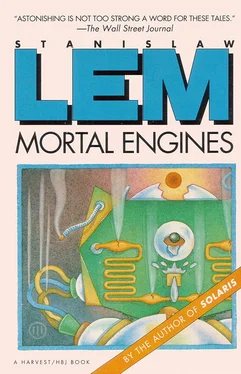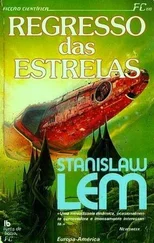Stanislaw Lem - Mortal Engines
Здесь есть возможность читать онлайн «Stanislaw Lem - Mortal Engines» весь текст электронной книги совершенно бесплатно (целиком полную версию без сокращений). В некоторых случаях можно слушать аудио, скачать через торрент в формате fb2 и присутствует краткое содержание. Город: London, Год выпуска: 1992, ISBN: 1992, Издательство: André Deutsch, Жанр: Фантастика и фэнтези, на английском языке. Описание произведения, (предисловие) а так же отзывы посетителей доступны на портале библиотеки ЛибКат.
- Название:Mortal Engines
- Автор:
- Издательство:André Deutsch
- Жанр:
- Год:1992
- Город:London
- ISBN:0-233-98819-X
- Рейтинг книги:3 / 5. Голосов: 1
-
Избранное:Добавить в избранное
- Отзывы:
-
Ваша оценка:
- 60
- 1
- 2
- 3
- 4
- 5
Mortal Engines: краткое содержание, описание и аннотация
Предлагаем к чтению аннотацию, описание, краткое содержание или предисловие (зависит от того, что написал сам автор книги «Mortal Engines»). Если вы не нашли необходимую информацию о книге — напишите в комментариях, мы постараемся отыскать её.
“Astonishing is not too strong a word for these tales”
(Wall Street Journal).
Mortal Engines — читать онлайн бесплатно полную книгу (весь текст) целиком
Ниже представлен текст книги, разбитый по страницам. Система сохранения места последней прочитанной страницы, позволяет с удобством читать онлайн бесплатно книгу «Mortal Engines», без необходимости каждый раз заново искать на чём Вы остановились. Поставьте закладку, и сможете в любой момент перейти на страницу, на которой закончили чтение.
Интервал:
Закладка:
“But why destruction?” asked the same voice as before.
“It is an automaton designed for mining operations,” Dr. McCork explained. “Its task was to have been the digging of levels or drifts, the boring through of rock, the crushing of particularly hard minerals, broadly speaking—the destruction of cohesive matter, obviously not everywhere and not everything, but as a result of its injury such a generalization came about. Anyway my hypothesis could be completely wrong. That side of the question, purely theoretical, will be worth considering later, after we have made a carpet of the thing. At present it is more important for us to know what the Setaur can do. It can move at a speed of about fifty kilometers an hour, over almost any terrain. It has no lubricating points, all the friction-joint surfaces work on teflon. Its suspensions are magnetic, its armor cannot be penetrated by any revolver or rifle bullet, such tests have not been made, but I think that possibly an antitank gun… But we don’t have any of those, do we?”
Achanian shook his head. He picked up the list that had been returned to him and read it, making little marks beside the names.
“Obviously the explosion of a fair-sized charge would pull it apart,” McCork went on calmly, as if he were talking about the most ordinary things. “But first you would have to bring the charge near it, and that, I am afraid, will not be easy.”
“Where exactly does it have its laser? In the head?” asked someone from the audience.
“Actually it has no head, only a sort of bulge, a swelling between the shoulders. That was to increase its resistance to falling rock. The Setaur measures two hundred and twenty centimeters in height, so it fires from a point about two meters above the ground; the muzzle of the laser is protected by a sliding visor; when the body is stationary it can fire through an angle of thirty degrees, and a greater field of aim is obtained when the entire body turns. The laser has a maximum power of forty-five thousand kilowatts. Any expert will realize that this is considerable; it can easily cut through a steel plate several centimeters thick…”
“At what range?”
“It’s a violet laser, therefore with a very small angle of divergence from the line of incidence… And therefore the range will be, for all practical purposes, limited to the field of vision; since the horizon here on a level plane is at a distance of two kilometers, two kilometers at the very least will be the range of fire.”
“We will be receiving special mining lasers of six times that power,” Achanian added.
“But that is only what the Americans call overkill,” McCork replied with a smile. “Such power will provide no advantage in a duel with the Setaur’s laser…”
Someone asked whether it wouldn’t be possible to destroy the automaton from aboard some cosmic vessel. McCork declared himself not qualified to answer; Achanian meanwhile glanced at the attendance sheet and said:
“We have here a navigator first class. Pirx … would you care to comment on this?”
Pirx got up.
“Well in theory a vessel of medium tonnage like my Cuivier, in other words having sixteen thousand tons rest mass, could certainly destroy such a Setaur, if it got it in its line of thrust. The temperature of the exhaust gases exceeds six thousand degrees for a distance of nine hundred meters. That would be sufficient, I think…?”
McCork nodded.
“But this is sheer speculation,” Pirx continued. “The vessel would have to be somehow brought into position, and a small target like the Setaur, which really isn’t any larger than a man, could always have time to move out of the way, unless it were immobilized. The lateral velocity of a vessel maneuvering near the surface of a planet, in its field of gravity, is quite small; sudden pursuit maneuvers are completely out of the question. The only remaining possibility, then, would be to use small units, say, the Moon’s own fleet. Except that the thrust here would be weak and of not very high temperature, so perhaps if you used one of those crafts as a bomber instead… But for precision bombing you need special instruments, sights, range finders, which Luna doesn’t have. No, we can rule that out. Of course it will be necessary, even imperative, to employ such small machines, but only for reconnaissance purposes, that is, to pinpoint the automaton.”
He was about to sit down, when suddenly a new idea hit him.
“Oh yes!” he said. “Jump holsters. Those you could use. I mean—you would have to have people who knew how to use them.”
“Are they the small, individual rockets one straps on over the shoulders?” asked McCork.
“Yes. With them you can execute jumps or even sail along without moving; depending on the model and type, you get from one to several minutes aloft and reach an altitude of fifty to four hundred meters…”
Achanian stood.
“This may be important. Who here has been trained in the use of such devices?”
Two hands went up. Then another.
“Only three?” said Achanian. “Ah, you too?” he added, seeing that Pirx, now understanding, had also raised his hand. “That makes four. Not very many… We’ll ask among the ground crew. Gentlemen I This is—it goes without saying—strictly a voluntary action. I really ought to have begun with that. Who of you wishes to take part in the operation?”
A slight clatter ensued, for everyone present was standing up.
“On behalf of Control I thank you,” said Achanian. “This is good… And so we have seventeen volunteers. We will be supported by three units from the lunar fleet, and in addition will have at our disposal ten drivers and radio operators to help man the transporters. I will ask you all to remain here, and you,” he turned to McCork and Pirx, “please come with me, to Control…”
Around four in the afternoon Pirx was sitting in the turret of a large caterpillar transporter, jolted by its violent motions. He was wearing a full suit, with the helmet on his knees, ready to put it on at the first sound of the alarm, and across his chest hung a heavy laser, the butt of which poked him unmercifully; in his left hand he had a map, and used the right to turn a periscope, observing the long, spread-out line of the other transporters, which pitched and tossed like boats across the debris-strewn tracts of the Sea of Tranquillity. That desert “sea” was all ablaze with sunlight and empty from one black horizon to the other. Pirx received reports and passed them on, spoke with Luna 1, with the officers of the other machines, with the pilots of the reconnaissance modules, whose microscopic exhaust flames every so often appeared among the stars in the black sky, yet with all of this he still couldn’t help feeling at times that he was having some kind of highly elaborate and stupid dream.
Things had happened with increasing frenzy. He wasn’t the only one to whom it seemed that construction headquarters had succumbed to something like panic. For really, what could one automaton-halfwit do, even armed with a lightthrower? So when at the second “summit meeting,” right at noon, there began to be talk of turning to the UN, at least to the Security Council, for “special sanction,” namely permission to bring in heavy artillery (rocket launchers would be best), and possibly even atomic missiles—Pirx objected along with others that in that way, before they got anywhere, they would be making complete asses of themselves in front of all Earth. Besides, it was obvious that for such a decision from the international body they would have to wait days if not weeks, meanwhile the “mad robot” could wander off God-knows-where, and once hidden in the inaccessible rifts of the lunar crust, you wouldn’t be able to get at it with all the cannons in the world; therefore it was necessary to act decisively and without delay. It became clear then that the biggest problem would be communications, which had always been a sore point in lunar undertakings. There supposedly existed about three thousand different patents for inventions designed to facilitate communications, ranging from a seismic telegraph (using microexplosions as signals) to “Trojan” stationary satellites. Such satellites had been placed in orbit last year—they didn’t improve the situation one bit. In practice the problem was solved by systems of ultrashortwave relays set on poles, a lot like the old pre-sputnik television transmission lines on Earth. This was actually more reliable than communication by satellite, because the engineers were still racking their brains over how to make their orbiting stations unsusceptible to solar storms. Every single jump in the activity of the sun, and the resultant “hurricanes” of electrically charged high-energy particles that tore through the ether, immediately produced a static that made it difficult to maintain contact—and sometimes for several days. One of those solar “twisters” was going on right now, thus messages between Luna 1 and Construction went by way of the ground relays, and the success of Operation Setaur depended—to a large degree, at least—on the “rebel” not taking it into its head to destroy the girdered poles that stood, forty-five of them, on the desert separating Luna City from the cosmodrome near the construction site. Assuming, of course, that the automaton would continue to prowl in that vicinity. It had, after all, complete freedom of movement, requiring neither fuel nor oxygen, neither sleep nor rest, in all so self-sufficient, that many of the engineers for the first time fully realized how perfect was the machine of their own making—a machine whose next step no one was able to foresee. The direct Moon-Earth discussions which had begun at dawn between Control and the firm Cybertronics, including the staff of Setaur’s designers, went on and on; but not a thing was learned from them which hadn’t already been said by little Dr, McCork. It was only the laymen who still tried to talk the specialists into using some great calculator to predict the automaton’s tactics. Was the Setaur intelligent? Well yes, in its own fashion! That “unnecessary”—and at the present moment highly dangerous—“wisdom” of the machine angered many participants in the action; they couldn’t see why in the hell the engineers had endowed such freedom and autonomy on a machine made strictly for mining tasks. McCork calmly explained that this “intellectronic redundancy” was—in the current phase of technological development—the same thing as the excess of power generally found in all conventional machines and engines: it was an emergency reserve, put there in order to increase safety and dependability of function. There was no way of knowing in advance all the situations in which a machine, be it mechanical or informational, might find itself. And therefore no one really had the foggiest notion of what the Setaur would do. Of course the experts, and those on Earth as well, had telegraphed their opinions; the only problem was that these opinions were diametrically opposed. Some believed the Setaur would attempt to destroy objects of an “artificial” nature, precisely like the relay poles or high-tension lines; others on the other hand thought that it would expend its energy by firing at whatever stood in its path, whether a lunar rock or a transporter filled with people. The former were in favor of an immediate attack for the purpose of destroying it, the latter recommended a wait-and-see strategy. Both were in agreement on this only, that it was absolutely necessary to keep track of the machine’s movements.
Читать дальшеИнтервал:
Закладка:
Похожие книги на «Mortal Engines»
Представляем Вашему вниманию похожие книги на «Mortal Engines» списком для выбора. Мы отобрали схожую по названию и смыслу литературу в надежде предоставить читателям больше вариантов отыскать новые, интересные, ещё непрочитанные произведения.
Обсуждение, отзывы о книге «Mortal Engines» и просто собственные мнения читателей. Оставьте ваши комментарии, напишите, что Вы думаете о произведении, его смысле или главных героях. Укажите что конкретно понравилось, а что нет, и почему Вы так считаете.












